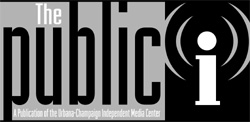|
|
|
|
|
Sarah
Kanouse: Art makes revolution by shooting
holes in the social fabric. Through these holes, glimpses,
visions and plans for other possibilities can be perceived.
Art for revolution is a window, not window-dressing.
Art for revolution disrupts the inevitability of social
and economic assumptions that have been normalized to
appear unassailable, unchangeable, even "natural"
and, "natural," then obviously "good."
The "naturalness" and "goodness"
of these conditions are reinforced daily by images and
representations which art for revolution counters, parries,
provokes. Existing social conditions emerged over time
not through divine intervention or some process of Darwinian
evolution but through human action that found patriarchy,
white supremacism, heterosexism, and anthropocentrism
helpful for the extraction of resources, coercion of
labor and accumulation of wealth. Most of the images
we see every day, from the obvious products of the entertainment
industry to artworks - even revolutionary artworks -
purchased by the targets of their critiques, are deployed
by those who benefit from these social constructs in
order to mask power and obscure the answer to the question
"Cui bono?"
Images deployed in the service of capital reinforce
existing social hierarchies by constantly reiterating
and simultaneously obscuring them. Images serve as visual
and visceral points for mobilizing personal desire and
political will not to imagine alternatives but to support
ideologies that may not actually be in the interests
of those consuming them. "High art" legitimizes
the elite by underscoring their commitment to a patronizing
form of "cultural enrichment," and even 'revolutionary'
images can excuse the powerful by pointing to their
roadmindedness in supporting critical artwork through
collectors and art institutions that effectively control
the ways such critical images are displayed and seen.
Art for revolution disrupts the manners in which images
serve capital. Art for revolution interjects questions,
provides missing information, and creates linkages that
are obscured by conventional images and the ideologies
they serve. It is almost inevitable that images with
revolutionary implications or intent will be appropriated
and commodified as soon as they become effective; appropriation
is the most effective form of censorship. The revolutionary
artist will simply keep making art, finding new ways
and new variations to use the subtle persuasiveness
of images to invite viewers to question that which was
not understood to be subject to question. Art for revolution
heals the inevitable wounds of social and economic institutions
by wounding their inevitability.
|
|
|
On
September 11, 2001, two hijacked commercial airliners
were flown into the World Trade Center. An estimated 6,000
people were killed in the collision and subsequent collapse
of the twin towers. |
|
|
|
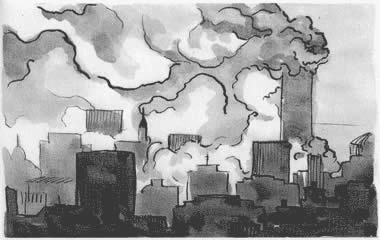 |
|
|
|
On
August 6, 1945, the US army dropped an atomic bomb on
Horoshima. The ruins of Sei Hospital lie directly beneath
the epicenter. |
|
|
|
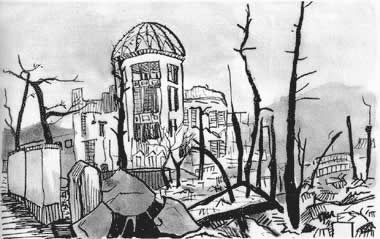
|
|
|
|
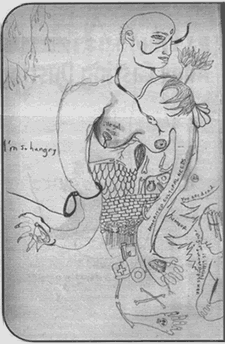 Bexa:
Art is probably the main reason I am still alive. Other
peoplesí or my own. Activismís okay and necessary, but
it isnít particularly satisfying or sustainable for
me (is it for you?). Bexa:
Art is probably the main reason I am still alive. Other
peoplesí or my own. Activismís okay and necessary, but
it isnít particularly satisfying or sustainable for
me (is it for you?).
Assert yourself: put your body? in front of the corporate-machine
gears? I exist in the merging place of despair and pleasure;
caught on the about-to-explode planet, looking for ways
to keep going despite The World. I donít think things
are gonna change too much in my lifetime, and nowadays
they are worsening in this country, and affecting everywhere
else disastrously (channeling Bushieís brain: "Lets
not sign the Kyoto Protocol: We do love our SUVs!")
I have some joy with friendships and dance and visual
art and masturbation and massage.
Also, I think "Happiness" is overrated, kind
of a cultural construct, as if itís something you can
just buy or work hard enough to get, as though itís
normal or healthy to be happy on a globe full of atrocity
and inequality.
I like feeling connected to the long history of protest
art; I can be an activist with what I make. I like feeling
connected to ancient human history, art being integral
to all cultures. Art carries the stories of a culture,
whether it is propagating racist beliefs and turning
them into truths, or spreading anti-racist demands.
Art grieves and bleeds and passions and processes and
dies and sleeps. Art can be anti-capitalist; donít be
tricked into thinking it is a bourgeois thing. It keeps
you alive; it is survival. Artís healing and wrenching
and fucking ecstatic and wants to destroy this whole
sickening system of torture and oppression, suffering
and loneliness. Art is a question that canít be answered.
Keep asking.
|
|
|
|
|
|
|
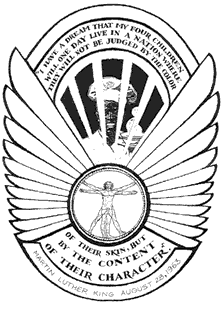 Chris
Evans: In the 60's, millions of people listened
to what Bob Dylan had to say (they probably still do).
What no one heard in 1966 was that Rubin "The Hurricane"
Carter was innocent of all charges that put him on death
row. Bob Dylan, the artist, was inspired to release
a song in 1976 that spelled out Mr. Carter's innocence.
Despite the same millions of people listening to that
song, Rubin Carter stayed in jail another 9 years. And
I doubt the appellate judge that released Carter from
jail in 1985 cited Bob's tune as a reason to overturn
the verdict. I say all that to say I am ambivalent about
the word "art" and "revolution" being in the same sentence.
I live in a time where the television show "Bart Simpson"
is my country's favorite to watch, yet George Bush's
son was able to get enough actual votes to allow the
Supreme Court to select him as president. I see corporations
using art more effectively nowadays to squash revolutions,
not propel them. I still do art, however, that seeks
"revolution" (or put another way, a "better solution")
because it's the only thing I know how to contribute
at the moment.
Chris
Evans: In the 60's, millions of people listened
to what Bob Dylan had to say (they probably still do).
What no one heard in 1966 was that Rubin "The Hurricane"
Carter was innocent of all charges that put him on death
row. Bob Dylan, the artist, was inspired to release
a song in 1976 that spelled out Mr. Carter's innocence.
Despite the same millions of people listening to that
song, Rubin Carter stayed in jail another 9 years. And
I doubt the appellate judge that released Carter from
jail in 1985 cited Bob's tune as a reason to overturn
the verdict. I say all that to say I am ambivalent about
the word "art" and "revolution" being in the same sentence.
I live in a time where the television show "Bart Simpson"
is my country's favorite to watch, yet George Bush's
son was able to get enough actual votes to allow the
Supreme Court to select him as president. I see corporations
using art more effectively nowadays to squash revolutions,
not propel them. I still do art, however, that seeks
"revolution" (or put another way, a "better solution")
because it's the only thing I know how to contribute
at the moment.
|
|
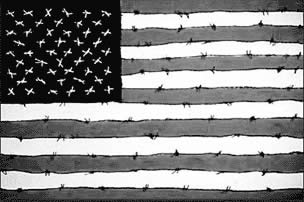
George Mullen, Freedom and Tyranny,
1997, 24" x 36", barbwire and oil on canvas.Copyright
© 1997 George Mullen. All Rights Reserved. Private
collection. www.studiorevolution.com
|
|
|
|
Art
is not a mirror to reflect reality, but a hammer with
which to shape it.
- Bertold Brecht
In
art, all who have done something other than their predecessors
have merited the epithet of revolutionary; and it is
they alone who are masters.
- Paul Gauguin
Art
is a step from what is obvious and well-known toward
what is arcane and concealed.
- Kahlil Gibran
All
that I desire to point out is the general principle
that Life imitates Art far more than Art imitates Life.
- Oscar Wilde
|
|
|
|
|
|
|
previous
page
|

